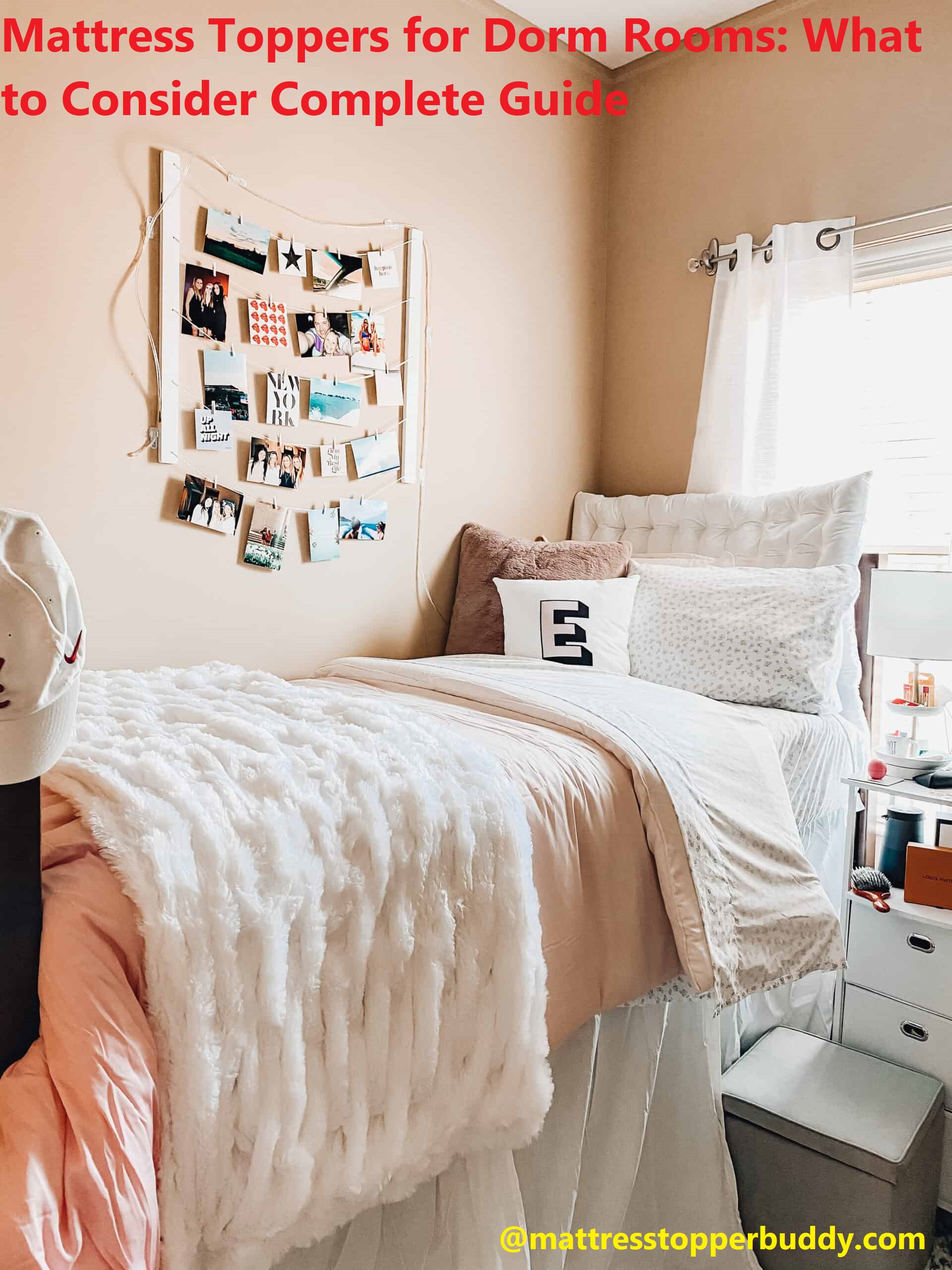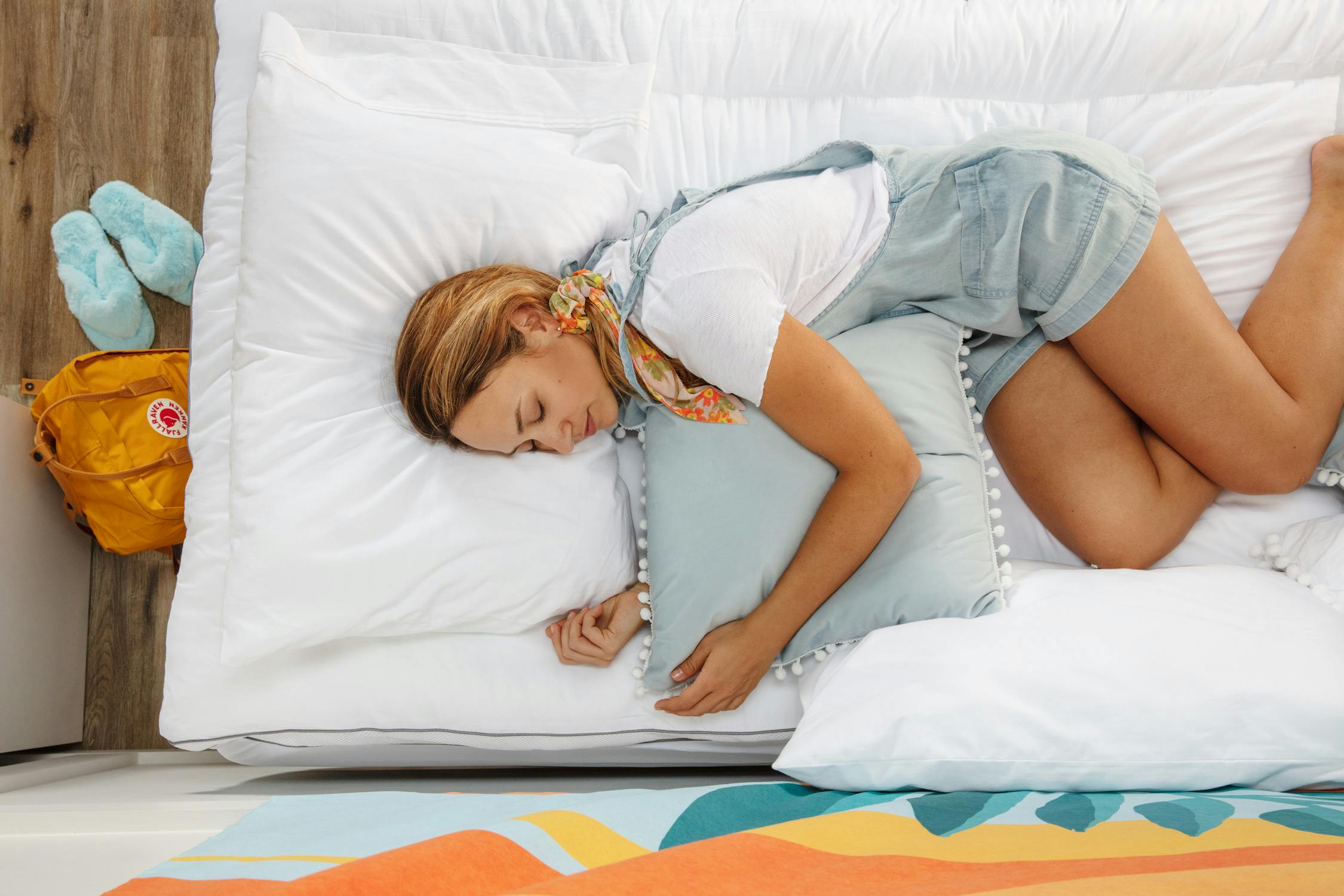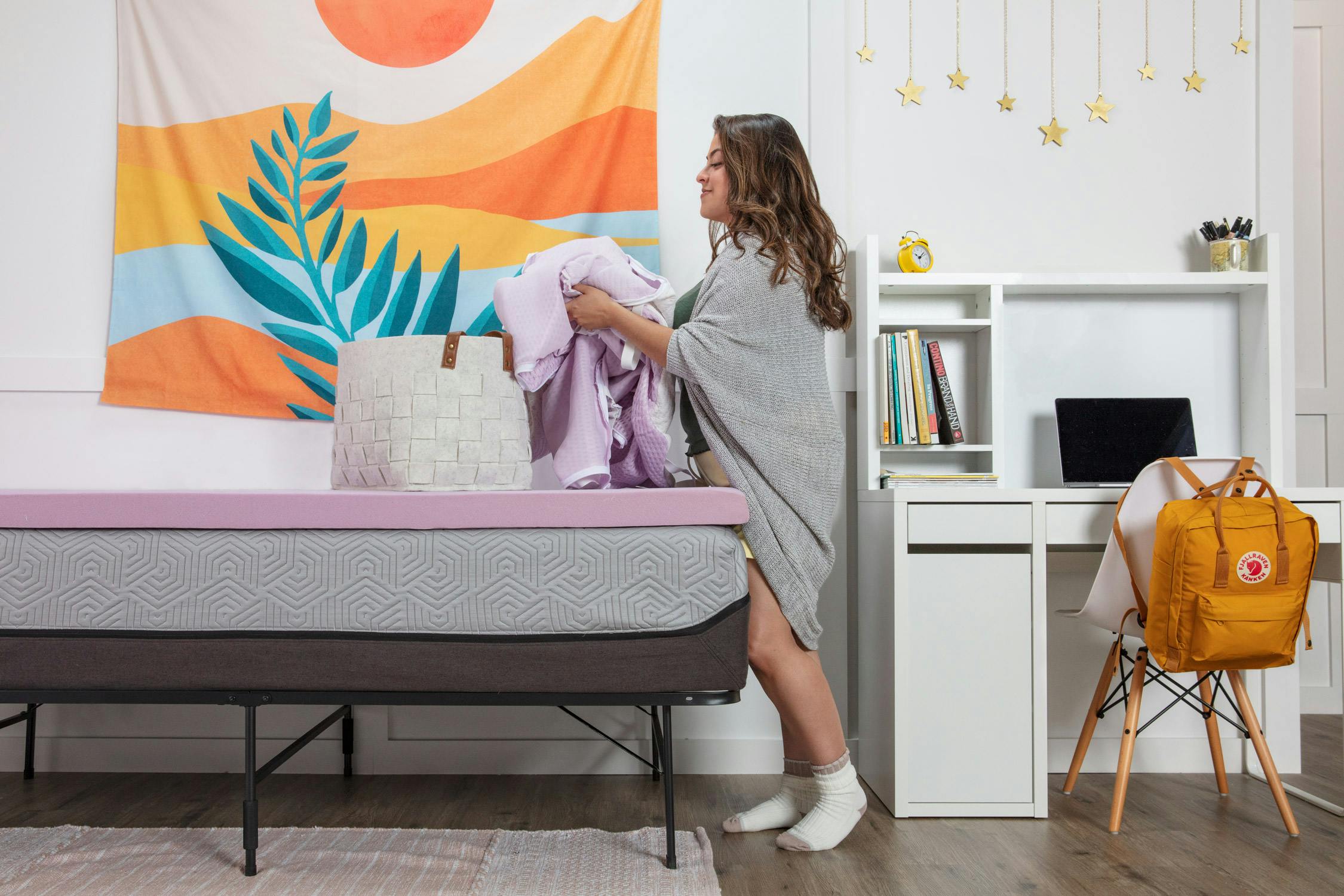Feeling overwhelmed with all the mattress toppers available for dorm rooms? You’re not alone.
This guide provides a comprehensive look at what to consider when shopping for a mattress topper for your college dorm. From materials, to firmness, and budget– we’ve got you covered!
When purchasing a mattress topper for a dorm room, it is important to consider the type of topper, the level of comfort and support you need, as well as your budget. Mattress toppers are available in multiple types such as natural latex, wool, down and cotton batting. Each type provides different levels of support and comfort based on the structure and materials used. Additionally, some mattress toppers can be washed or vacuumed for easier maintenance.
Furthermore, many mattress toppers use temperature-regulating materials that can help keep you cool during warmer months and warm during colder months. Also consider the size of your dorm bed when shopping for a mattress topper – some sizes may be too large or small for your current bed setup. Lastly, be sure to factor in how much you are willing to spend on a mattress topper – some will cost more than others depending on the materials used and what they offer. We provide an overview of mattress types below so that you can make an informed decision when selecting the right one for your dorm room setup.
Explanation of mattress toppers
When our backs and shoulders need a little extra support and cushioning, we often turn to mattress toppers. Whether you’re seeking comfort, hygiene or support considerations, mattress toppers can provide the perfect solution in a variety of situations. To help you make the right choice for your dorm room, here is an overview of what mattress toppers are and the different types available.
Mattress toppers are additional layers of padding placed on top of a firm or hard mattress. They come in a variety of sizes and thicknesses, so they can be matched with any type and size of mattress regardless of its condition. Mattress toppers can instantly transform uncomfortable beds into much cozier sleeping surfaces by providing just the right amount of softness and support. Many people who suffer from back pain or arthritis can find temporary relief from their discomfort with the addition of a good quality mattress topper.
The main types of mattress topper for dorm rooms include featherbeds (filled with feather down or synthetic materials that mimic natural feathers), memory foam mattresses, cotton-filled mattresses, latex hybrid mattresses (combined with other base foams) and wool-filled bedding options that offer natural temperature regulation benefits. When considering which type is best suited for your needs, think about your current sleeping habits – how firm do you like your bed? How much cushioning should it have? How supportive should it be? Do you like traditional bedding items made from natural materials such as cotton or wool?
It’s important to research each different type thoroughly before making a purchase in order to ensure maximum satisfaction and optimal comfort throughout the night!

Importance of choosing the right mattress topper for dorm rooms
When shopping for a dorm-friendly mattress topper, it’s important to consider the needs of the user. Pain and pressure relief is a must in any dorm room, particularly with the amount of time students spend studying and doing homework on their vertical surface (bed)! To maximize comfort and protect your spine, look for a mattress topper that’s made of memory foam or latex foam, both of which are proven to offer superior support.
It’s also important to consider the breathability of your mattress topper—thinking through its composition (are there layers? is there temperature control?) before investing in one. Lastly, given their versatility and portability aspects, lightweight inflatable mattress topppers are becoming increasingly popular among college students. They can be quickly inflated or deflated for use during road trips or other activities away from campus.
With some thought regarding your priorities and budget, you can find the perfect mattress topper for any dorm room!
Comfort
Comfort should be an important factor when considering what mattress topper to buy. Ultimately, the mattress you choose should provide you with a good night’s sleep. Although foam is often considered one of the most comfortable mattress toppers available, some find latex more suitable. Part of finding the right comfort comes down to personal preference so be sure to do your research.
Foam Mattress Toppers: Foam mattresses come in a variety of shapes and sizes, and are typically quite soft and plush. Most are made from layers of polyurethane foam or memory foam, which contours to your body for added support and comfort. Foam is resilient and cushioning, providing both pressure relief and great support for all body types. If you suffer from back pain or joint pain, consider investing in a memory foam mattress (or a hybrid). Memory foam absorbs movement so it’s ideal for couples who share a bed as it minimizes disturbance for either partner.
Latex Mattress Toppers: Latex mattresses are less common than foam mattresses but growing in popularity due to their high levels of comfort and durability. Latex is well known for being resilient while also providing excellent support throughout the night while resisting temperature fluctuations which can make some mattresses feel too hot or too cold depending on the climate in your dorm room. Latex is also often hypoallergenic which makes it an ideal choice if you suffer from allergies or asthma as well as being more affordable than other varieties of mattress topper on the market such as memory foam or adjustable air beds.
Importance of comfort for a good night’s sleep
Comfort is perhaps the most important factor to consider when shopping for mattress toppers for your dorm room. If a mattress is comfortable, it can help improve sleep quality and leave you feeling refreshed in the morning. However, if a mattress does not provide the necessary support or comfort level required, it may result in pain, restlessness and an uncomfortable night’s sleep.
Most mattress toppers are designed to add cushioning and contouring comfort to existing mattresses. Choosing a higher-quality mattress pad or topper can be beneficial as they are usually more durable and adjustable while providing superior comfort. Additionally, several types of material are employed in constructing such pieces including jersey knit cotton, quilted cotton fabrics, wool batting and foam layers which add additional cushioning and relief from pressure points.
Different types of mattress toppers
When shopping for a mattress topper, it’s important to know what type of material will best suit your needs. The five main types are:
Memory Foam: These are among the most popular mattress toppers due to the combination of comfort and support they provide. Memory foam molds itself to your body, providing cushioned support. It also absorbs movement, so tossing and turning won’t affect the other sleeper.
Latex or Wool: Latex or wool are both excellent for people with allergies, since neither traps dust mites or allergens that can cause irritation. Latex is very resilient and supports the body in an even way without allowing it to sink in too deeply, while wool is comfortable and cozy.
Gel Memory Foam: Gel memory foam is a mix of traditional memory foam and gel beads that absorb excess heat while still molding around your body for comfort and support.
Featherbeds/Down-Alternative Toppers: Lightweight and breathable, down-alternative mattress toppers provide soft cushioning without trapping too much heat. They often come with removable covers so you can easily clean them when needed.
Fiberfill Toppers: These feel like traditional mattresses with layers of fluffy feathers or cotton batting for comfort and warmth throughout the night. The material does not hug curves like memory foam does, but instead provides a reliable cushion over time that should stay smooth even after use (unlike traditional featherbeds).
How to choose the right level of comfort
In order to choose the right level of comfort for your mattress topper, you need to consider a few things first. Start by deciding what type of support you’re looking for. It can be divided into three categories – soft, medium and firm. Generally, firmness ratings start at 1 and go up to 10, with 1 being the softest and 10 being the firmest.
The next thing you should consider is your sleeping position – this will help determine which type of mattress topper is best for you. Side sleepers tend to benefit more from soft or medium-firm mattress toppers, as they provide extra cushioning that keeps the spine properly aligned. Stomach sleepers should opt for a firmer surface in order to reduce sinking and support their hips. For back sleepers, a medium surface works best as it provides balance between sinkage and support.
Different materials also provide different levels of comfort – so be sure to read product descriptions carefully before purchasing a mattress cover or mattress pad! Natural fibers like cotton or wool provide breathability while memory foam or latex can give extra cushioning. Additionally, you may want to look into temperature regulation features if hot flashes are an issue at night due to menopause or other factors.
Finally, make sure the size of your mattress cover matches the size of your mattress! A twin-sized cover on a full-sized bed will result in an uncomfortable experience when sleeping – no matter how much cushioning it might have!
Size and Fit
Before you purchase a mattress topper, it’s important to be aware of the size and fit that you need. This means measuring your mattress dimensions, taking into account whether you want a standard or deep-pocket fit, and determining whether an extended-length option would be necessary.
To ensure proper coverage, get an exact measure of your mattress’s length and width so that the topper doesn’t slide or bunch up when in use. If you are buying a standard deep-pocket mattress topper, measure the thickness of your mattress as the extra padding should be no more than 3 inches.
If you decide to go with an extended-length option make sure that the toes of your feet still touch down on the floor beneath while sleeping. This can help regulate body temperature by removing trapped heat from contact points such as hips and shoulders.

Importance of getting the right size and fit for a dorm room mattress
When looking for a mattress topper for a dorm room, one of the most important considerations is getting the right size and fit. Mattress toppers come in standard sizes: Twin, Full, Queen, and King. The type of mattress topper that you buy should be appropriate for your mattress size. For instance, if you have an extra-long twin sized dorm room mattress, it might not be suitable for a standard twin-sized mattress topper. Similarly, if you have a full-sized bed in your dorm room and decide to purchase a queen-sized mattress topper, it might not fit correctly.
You should also consider whether or not your chosen mattress topper will fit comfortably on your bed frame or if there are any conflicting features that could prevent it from fitting properly. Bulkiness of the topper can also play a role in whether or not the product will provide adequate support on or near the edge of the bed frame. Lastly, make sure that any box spring, platform frame or other support system you plan on using with this new mattress topper will be able to accommodate both pieces without compromising their functionality and comfortability. Having these types of conversations with customer service personnel from retailers may help ensure that you get ideal fitting pieces while avoiding needless returns due to improper sizing before they arrive at your door.
Standard mattress sizes and topper dimensions
When outfitting your dorm room, standard mattress sizes and topper dimensions play a significant role. In the United States and Canada, typical bedding sizes are twin, twin XL, full, queen, king and California king. Before you purchase your mattress topper, make sure it correlates with the size of your college-issue mattress.
Twin mattresses are commonly furnished in college dorms and measure 39 inches wide by 75 inches long. A typical twin topper also requires a fitted sheet that has a minimum of an 8-inch pocket depth. For an extra-long twin bed (commonly referred to as a “twin XL”), the mattress is 5 inches longer than a standard twin and extends up to 80 inches long. Toppers for these types of beds may fit a standard pocket depth fitted sheet, but check with the manufacturer for specifications before making your purchase.
Full mattresses usually measure 54 inches wide by 75 inches long and require at least an 11-inch deep pocket sheet — again, double check specifications with the manufacturer if you have any concerns about compatibility. Queen size mattresses measure 60 inches wide by 80 inches long while king size mattresses measure 76-by-80 in width/length respectively; both require sheets with at least an 11 or 12 inch deep pocket depending on the desired amount of coverage over the edges of the topper itself. California King size beds are 4″ shorter in length than their traditional counterparts while 6″ wider; they require sheets that have up to a 13 inch pocket depth for optimal coverage over thicker mattress pads such as buckwheat hulls or other high loft products as desired.
How to measure the dorm room mattress
Before selecting a mattress topper for your dorm room, it’s important to take accurate measurements of the bed. A standard twin-sized bed is 39 by 75 inches, a full-sized bed is 54 by 75 inches and a queen-sized bed is 60 by 80 inches.
Once you have the correct measurements, you’ll want to choose an appropriate mattress topper size. Mattress toppers are usually available in twin, twin XL, full and queen sizes that vary slightly from these standard mattress sizes. For example, a typical twin sized topper measures 38 x 74 inches and twin XL range from 38 x 80 – 40 x 80 inches depending on the brand. Full size mattress toppers measure 53 – 54 x 75 – 76 inches while queen size mattress pads range from 60 x 78 – 80 x 78 – 80 inches again depending on brand name and type of product.
Finally, when measuring for depth accuracy matters since too much padding can result in an uncomfortable sleep experience should be avoided as it can make the sleeping surface feel too soft or lumpy. Common depth options for mattress toppers include one inch (2 cm), two inch (4 cm) three inch (7 cm) or even four inch (10 cm). Each of these levels will provide a distinctly different feel so choosing the right amount is based on personal preference and comfort level as well as budget considerations since price increases with depth selection.
Conclusion
In conclusion, investing in a mattress topper can be a good investment for any college student living in a dorm room. With the right information and some careful purchases, students can find the mattress topper that works best for their needs and lifestyle.
The most important things to keep in mind when choosing a mattress topper are your body type and personal preferences. You should also consider the comfort level of your bedding, the thickness of your mattress topper, and whether or not you will use it for more than one semester. By researching different types of materials and paying attention to details such as certifications, you can ensure that you make an informed purchase that you won’t regret.

FAQ’s
How thick should a mattress topper be for a dorm?
The thickness of a mattress topper for a dorm depends on personal preference, but usually, a 2-3 inch topper is sufficient.
How do I choose a college mattress topper?
When choosing a college mattress topper, consider factors such as the material, thickness, firmness, and breathability. Also, check if it fits the dorm bed size.
Do you need a mattress topper for college dorm?
A mattress topper is not necessary for a college dorm, but it can provide added comfort and support to the mattress.
What do you put on top of a dorm mattress?
On top of a dorm mattress, you can put a fitted sheet, a mattress protector, a mattress topper, a flat sheet, a comforter or duvet, and pillows.
Is 3 inch mattress topper too thick?
A 3 inch mattress topper is not too thick but can be too much for some people’s preferences. It is best to try out different thicknesses to find the one that suits you.
Is a 4 inch mattress topper too much?
A 4 inch mattress topper can be too much for some people, as it can alter the feel and support of the mattress. It is best to consider personal preference and try out different thicknesses before making a decision.
Are mattress toppers good for college?
Mattress toppers can be good for college, as they can provide added comfort and support to the typically uncomfortable dorm mattresses.
Is it better to have mattress topper too big or too small?
It is better to have a mattress topper that fits the mattress size properly. A topper that is too big or too small can be uncomfortable and affect the mattress’s support.
Is a 2 inch foam topper good?
A 2 inch foam topper can be good for providing added comfort and support to a dorm mattress, but it depends on personal preference.
What is a typical dorm mattress?
A typical dorm mattress is a Twin XL size, which is 80 inches long and 39 inches wide, and is usually made of a low-quality foam material.
See Also :
- Best mattress topper for twin XL dorm bed
- Best mattress topper for stomach sleepers
- Best mattress topper for stomach and side sleepers
- Best mattress topper for sofa bed
- Best mattress topper for side sleepers

